Thursday, March 30, 2006
Lesson
My latest post "Old Eversharp Pencils" is actually posted below "State of the NZ Pencil" because I originally had a draft saved a while ago, and just altered and posted that draft thinking it would update to todays date, but it doesn't. The draft publishes in order of the date it was created not the date it was finalised and finally published. So sorry, you will have to scroll down a bit to get the latest posting "Old Eversharp Pencils". I'll try not to make the same mistake twice!
Tuesday, March 21, 2006
State Of The NZ Pencil, 2006
Mechanical Pencil Brands
Apart from the less expensive brands, most of these brands are usually only available in pencil format on request. Their pens are readily available, but mechanical pencils would normally have to be ordered in from the local distributor, who in turn may sometimes have to specially import them. For example you do not normally see Parker, Shaeffer or Waterman pencils, but their pens are widely available. Also many of the brands have only a limited range offered in NZ. For example the Pentel distributor in NZ made a passing comment to me that they imported “much less than ½” of the Pentel range, e.g. the Sharp Kerry is not available in NZ. Some of the brands may not have official distributors in NZ, large retailers may just direct import shipments on a regular or occasional basis.
Available
Artline, BIC, Cross, Faber-Castell, Inoxcrom, Lamy, Marbig, Mont Blanc, Papermate, Parker, Pentel, Rotring, Shaeffer, Stabilo, Staedtler, uni, Waterman, Zebra.
Notes
- Tombow – recently withdrawn from NZ?
- Many generic / housebrand mechanical pencils are also available. They generally appear to be of Chinese origin.
- Cross is available, but I never see them anywhere, not even their pens!
Uncommon / Unsure of Status
(Never really see them, but some local information implies they are available)
Aurora, Pelikan, Pilot (pens are available, but I never see their pencils), Sensa
Wood Case Pencil Brands (Plain graphite only – coloured pencils not included)
Available
Columbia, Faber-Castell, Stabilo, Staedtler, Wolff
Notes
- Only Staedtler & Faber-Castell are widely available, but only a limited number of their models may be imported into NZ. A few other well-known brands (e.g. Koh-I-Nor, Derwent) are supposedly available from small online retailers or small specialist stores.
- Many high schools specify Staedtler by name as the pencil to use for their classes. Graphics, Technology and Music courses commonly specify a pencil(s) in their students stationery requirements list. Not sure why Faber-Castell’s lawyers aren’t getting themselves involved in this!
- Many generic / housebrand pencils are also available. They generally appear to be of Asian origin.
Sunday, March 19, 2006
Old Eversharp Pencils
For a pen manufacturer, quite a lot has been written about the US Wahl Eversharp company - their origin, rise and fall, the Japanese connection and relationship with the modern Sharp Corporation. It’s an interesting tale with a few different versions, and its fair share of fact and fiction.
Whatever the stories, Wahl Eversharp were a major player in the pen / pencil market of the early and mid 20th century, so I guess its not too surprising that I have a few of their pencils. So here’s a little bit on my small collection of Eversharps. I apologise for my limited photographic ability - for the pencils with engraved decoration on their body, I have rough sketched the pattern beside it, so that you can get some idea of what it looks like in real life.
Small Gold Ringtop

First off is this small plain gold filled ringtop Wahl Eversharp pencil. It is a twist top screw / slider mechanism, i.e. you twist the top around and the mechanism pushes the lead out the tip. Thats one way - the lead doesn't go back in. (I’ll write a bit more about this in a future posting on Mechanisms). Gold filled is a terminology not really used today – basically it just means a layer of gold over a base metal. Today we would probably just say gold plated and not really distinguish between the various means of getting that layer of gold onto the base metal. Ringtop pencils seem to have been fairly common as there are lots of models made by many manufacturers. I guess people picked up pencils and walked off with them in the old days just like today, so tying your gold pencil down was the smart thing to do! I have no idea when this pencil is from, I imagine sometime from the 1920’s to 40’s.
Three Gold Pencils
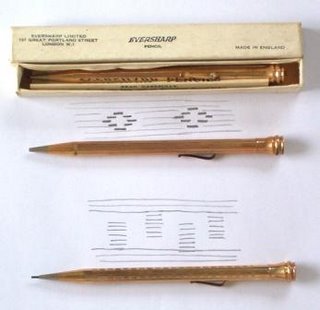 Next are these three gold filled Eversharps of English manufacture. The Wahl identity does not seem to have been used in the UK, and they just used Eversharp branding. These three are all the same model, just different body decoration. They basically have the same twist top mechanism as the ringtop. Note the very small pocket clips.
Next are these three gold filled Eversharps of English manufacture. The Wahl identity does not seem to have been used in the UK, and they just used Eversharp branding. These three are all the same model, just different body decoration. They basically have the same twist top mechanism as the ringtop. Note the very small pocket clips.These three were sold to me as “New Old Stock”, a local stationers sample set from the 1950’s. This is the instruction sheet that comes with
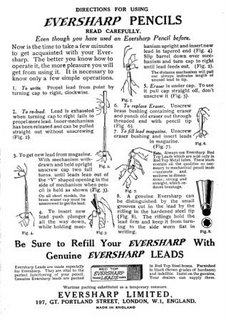 these English pencils. I like the line down the bottom, “Wartime packaging substituted as a temporary measure”. Completely different war, but it always reminds me of my grandmother and her childhood memories of the Zeppelins over London in World War 1, before she emigrated to NZ. But back to the war in question, World War 2 ended in 1945, but its easy to forget how long the economic effects lasted. For instance food rationing didn’t end in the UK until 3 July 1954 when meat and bacon again became freely available. Imagine that for nearly 15 years people in England couldn’t just go to the shops and buy a nice steak or some pork chops whenever they wanted. No Sunday morning fry-up for 15 years! New Zealand is way out at the end of the supply chain so its probably not unusual to find wartime restriction stock still in circulation in the 1950’s. I believe these pencils sold for 51 NZ shillings in the 1950’s. This was about half the average weekly wage back then, so they weren’t cheap. In comparison with todays incomes that would mean they would now retail in New Zealand for something like US$275. On the price scale I use for my reviews that easily puts them into the “stratospheric” range. I haven’t done any research, but I imagine that in 1950’s New Zealand there was strict import licensing control and customs tariffs on luxury items like these pencils.
these English pencils. I like the line down the bottom, “Wartime packaging substituted as a temporary measure”. Completely different war, but it always reminds me of my grandmother and her childhood memories of the Zeppelins over London in World War 1, before she emigrated to NZ. But back to the war in question, World War 2 ended in 1945, but its easy to forget how long the economic effects lasted. For instance food rationing didn’t end in the UK until 3 July 1954 when meat and bacon again became freely available. Imagine that for nearly 15 years people in England couldn’t just go to the shops and buy a nice steak or some pork chops whenever they wanted. No Sunday morning fry-up for 15 years! New Zealand is way out at the end of the supply chain so its probably not unusual to find wartime restriction stock still in circulation in the 1950’s. I believe these pencils sold for 51 NZ shillings in the 1950’s. This was about half the average weekly wage back then, so they weren’t cheap. In comparison with todays incomes that would mean they would now retail in New Zealand for something like US$275. On the price scale I use for my reviews that easily puts them into the “stratospheric” range. I haven’t done any research, but I imagine that in 1950’s New Zealand there was strict import licensing control and customs tariffs on luxury items like these pencils.Sterling Silver Pencil
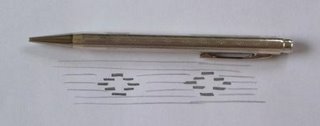 Last up is this sterling silver Eversharp, again of English manufacture. Unlike the others it has a modern style push top ratchet mechanism. Also it is solid silver, not silver plated. It was sold to me as a “1940’s” pencil. Now I’m certainly no expert but I read the hallmarks as being 1955 London Assay office, close to the end of the Wahl Eversharp company history.
Last up is this sterling silver Eversharp, again of English manufacture. Unlike the others it has a modern style push top ratchet mechanism. Also it is solid silver, not silver plated. It was sold to me as a “1940’s” pencil. Now I’m certainly no expert but I read the hallmarks as being 1955 London Assay office, close to the end of the Wahl Eversharp company history.
Saturday, March 18, 2006
Two Bad Buys
The Sakura 125
Sakura are a reasonably large Japanese manufacturer of markers, pens, etc but I don’t know that much about them. Their mechanical pencils don’t appear to be widely available via online retailers. About 7 or 8 years ago some NZ office supply companies started selling their mechanical pencils. I assume it was an unsuccessful venture, as they didn’t last long in the market. However, during this time the Sakura 125 pencil became commonplace at my work, but there are two things wrong with it.
 First the pocket clip is useless. You can see that it doesn’t go anywhere near to touching the body, so it doesn’t grasp any fabric between the body and clip, unless it is a really thick garment. Secondly, the mechanism is very unreliable, which is strange as even cheap pencil mechanisms generally seem quite reliable. Within a few months I had half a dozen or so pencils with jammed mechanisms, and my work colleagues had similar experiences. So basically a poor quality pencil, not worth the money you pay for it.
First the pocket clip is useless. You can see that it doesn’t go anywhere near to touching the body, so it doesn’t grasp any fabric between the body and clip, unless it is a really thick garment. Secondly, the mechanism is very unreliable, which is strange as even cheap pencil mechanisms generally seem quite reliable. Within a few months I had half a dozen or so pencils with jammed mechanisms, and my work colleagues had similar experiences. So basically a poor quality pencil, not worth the money you pay for it.Now, poor quality is one thing, but when you really start scraping the bottom of the barrel, you find ….
The Papermate Advancer
 Now this one really gets me annoyed. A non-refillable mechanical pencil?!? Yes, that’s right, when the lead runs out you cannot refill it. I always thought that refillability was an inherent functional concept of mechanical pencils. Apparently it says non-refillable on the packaging, but even today I only ever see them as loose open stock in retail bins. There is no mention anywhere on the bins or on the pencil itself about it being non-refillable. Even worse, lots of them have half the lead already used from people trialing them, flicking the tip to see how the auto-advance mechanism works, etc. When I bought mine I had no idea it was non-refillable, and it had no lead left in it at all! It was the only one of that colour in the store, I knew it was empty but I just thought I’d refill it at home! Imagine if you bought a woodcase pencil and there was only lead up the first ¼ of the pencil, and the rest was just solid wood. Or a car that had a tank of petrol that you couldn’t refill. Wrong, wrong, wrong, wrong, wrong! That’s what it feels like. Poor quality is one thing, but I think this is just outright misleading, I feel completely and utterly ripped-off!
Now this one really gets me annoyed. A non-refillable mechanical pencil?!? Yes, that’s right, when the lead runs out you cannot refill it. I always thought that refillability was an inherent functional concept of mechanical pencils. Apparently it says non-refillable on the packaging, but even today I only ever see them as loose open stock in retail bins. There is no mention anywhere on the bins or on the pencil itself about it being non-refillable. Even worse, lots of them have half the lead already used from people trialing them, flicking the tip to see how the auto-advance mechanism works, etc. When I bought mine I had no idea it was non-refillable, and it had no lead left in it at all! It was the only one of that colour in the store, I knew it was empty but I just thought I’d refill it at home! Imagine if you bought a woodcase pencil and there was only lead up the first ¼ of the pencil, and the rest was just solid wood. Or a car that had a tank of petrol that you couldn’t refill. Wrong, wrong, wrong, wrong, wrong! That’s what it feels like. Poor quality is one thing, but I think this is just outright misleading, I feel completely and utterly ripped-off!Luckily there is a hack that allows you to refill it, but I still feel like I’ve been scammed. Papermate now also make a refillable version called the Auto Advance. I will review that in the future, and try to be objective.
Friday, March 17, 2006
Review Process & Price Ranges
Review Process
Just so it’s clear, this is basically how I do my reviews.
- I own the pencil in question, unless I make it clear that I don’t. There are no rewards involved, this is purely a “labour of love”.
- I use the pencil for a reasonable period of time. Usually I use it in my office at work for a full week. So obviously there aren’t many “new” pencils in my collection. I do try and take good care of them, so basically they are all “near new”, “excellent”, or some other such description.
- I make notes during the evaluation period and write them up afterwards. I’m not trying to fully describe and review every detail of the pencil and its construction. There are manufacturers and retailers sites that have that sort of information. I am trying to give some idea about the things I like and don’t like about the pencil, (and why), along with some general information.
- I try to be impartial, objective, and all those sorts of things, but you will have to be the judge of how well I succeed at that.
Price Ranges
Just to give some idea of the price of a pencil, I include a price range. These are just rough guides only, based on an average price from a quick search of online retailers. The ranges are, in US$:
$0 – 3 Economy
$3-15 Low
$15 – 50 Mid
$50 – 150 High
$150+ Stratospheric
Saturday, March 11, 2006
Staedtler graphite 777 Mechanical Pencil Review
If you search the blogs for pencils or mechanical pencils you get a lot of results for artists mentioning the pencil they use for their artwork. Now I have looked at a few of these sites and there are a lot of talented people out there. One thing that has really surprised me though is the number of people who seem to be drawing with thin lead mechanical pencils. I am not surprised at them using mechanicals, it’s the thin lead bit that I find surprising.
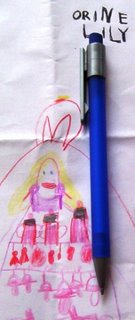 There are a number of mechanical pencils advertised as “sketch” pencils; usually they are clutch mechanism (or leadholder) types, with thick leads in the 1.5 to 3mm sort of range. Some are even thicker again. I have absolutely zero artistic ability, but have always imagined 0.5 / 0.7mm leads to be a bit thin for drawing, and that artists would be using something thicker. So I asked a couple of these artists what particular pencil they used, and there was a common thread amongst their replies, namely something cheap and disposable because they frequently lost their pencils. Some were almost apologetic or embarrassed about using a “cheap” pencil. So my surprise deepened. Not only were my lead thickness ideas wrong, but my idyllic image of them sketching away with a fine mechanical pencil from Lamy or Faber-Castell was also out of the window. Just how wrong could I be? I do have trouble getting my head around this. They invariably draw on good quality paper like Moleskine notebooks, but their drawing instrument is seemingly of little consequence.
There are a number of mechanical pencils advertised as “sketch” pencils; usually they are clutch mechanism (or leadholder) types, with thick leads in the 1.5 to 3mm sort of range. Some are even thicker again. I have absolutely zero artistic ability, but have always imagined 0.5 / 0.7mm leads to be a bit thin for drawing, and that artists would be using something thicker. So I asked a couple of these artists what particular pencil they used, and there was a common thread amongst their replies, namely something cheap and disposable because they frequently lost their pencils. Some were almost apologetic or embarrassed about using a “cheap” pencil. So my surprise deepened. Not only were my lead thickness ideas wrong, but my idyllic image of them sketching away with a fine mechanical pencil from Lamy or Faber-Castell was also out of the window. Just how wrong could I be? I do have trouble getting my head around this. They invariably draw on good quality paper like Moleskine notebooks, but their drawing instrument is seemingly of little consequence.One particular artist was OMWO from “The Way of the Indiscreet Mechanical Pencil” and he said that he currently used the Staedtler 777. I thought that if it’s good enough for him, I should give it a try, and went to the store and bought one. So, obviously a brief review of the Staedtler 777 is in order.
The Staedtler “graphite 777” is a basic lightweight all plastic economy model mechanical pencil available in 0.5 and 0.7mm lead. It has a push top ratchet mechanism with a fixed tip. The body comes in a variety of attractive, bright, almost semi-transparent colours, and is slightly flexible with an almost rubber feel to it. I quite like this flexy body concept, and there is no problem with where to grip this pencil (anywhere you like), but it does start to bring out my anti-rubber grip feelings. The uncovered eraser on top is a matching colour to the body. Bare erasers are a feature of many economy pencils – I guess manufacturers save a few cents by not putting a cap on the eraser. This means you can see a dirty smeared worn down eraser, but on the other hand you have quick and easy access to it. The eraser is a decent size and seems to erase fairly well.
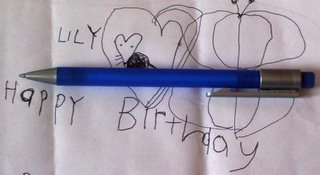
You load more leads into the mechanism by pulling the entire pocket clip section off the body. I do wonder about the long-term viability of this arrangement, but it is Staedtler (serious German engineering), so I’m sure you would get your money’s worth from it. This arrangement does mean that you can use the eraser, insert a new eraser and refill the lead magazine all without activating the lead advance mechanism. That’s more than many a pencil can claim. So, overall this is a perfectly good economy grade pencil.
- Best Points – Interesting “flexy” body in a range of bright attractive colours.
- Not So Good Points – “Rubbery” feel to the body, uncovered eraser – but give them some points for the matching colour scheme.
- Price Range – Economy
Dimensions: 144mm long, 8mm diameter.
Now if any artist ever actually reads this blog, I would really like to know about the mechanical pencil you use, and your thoughts on it. Thin lead or thick? Why? Cheap disposable pencil or something more? Do you think your pencil is an important part of your art? If so, don’t you want a good quality mechanical pencil like a craftsman wants a good reliable tool? Or is it only the quality of the lead that counts – lead is a consumable and the holder is irrelevant beyond basic functionality? So take pity on an envious engineer, one who can’t draw without a T-square and template, and thinks that 0.7mm is a really fat line. Enlighten me!
Monday, March 06, 2006
Caran d'Ache Varius Ivanhoe Mechanical Pencil Review
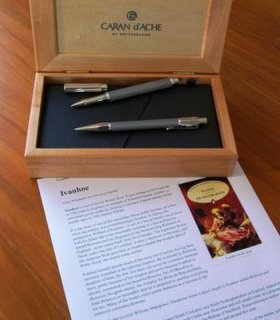
The Caran d’Ache Varius range of writing instruments is available in a variety of different body decorations, e.g. lacquer, wood, carbon fibre, etc. “Varius” translates to “various” in English, so I’m sure you get the idea. The model that I really like is “Ivanhoe”. It is supposedly a tribute to the great historical novel “Ivanhoe” by Sir Walter Scott, a classic story of bold knights and beautiful maidens. I guess some marketing person at Caran d’Ache really got carried away with this whole thing, but it’s an interesting gimmick. So being a tribute to a knight, the Varius “Ivanhoe” is decorated with a “coat of mail” on its body. I’m afraid that my photographs really don’t do it justice; it looks a lot better in real life.
The coat of mail is the first thing you notice about this mechanical pencil. It is a very fine metal mesh wrapped around the central body. It looks great! The pencil is rhodium plated so it's very shiny and shimmery, and you get those changing angular patterns in the mesh as you alter the angle you are looking at it from. The body is hexagonal at either end, and the large push-button top and
 pocket clip all go with the armour theme. I can really see this being the sort of mechanical pencil a knight would have chosen, if they had been invented back then! The “Ivanhoe” range should also be the choice of today’s military person.
pocket clip all go with the armour theme. I can really see this being the sort of mechanical pencil a knight would have chosen, if they had been invented back then! The “Ivanhoe” range should also be the choice of today’s military person.Visually this pencil is a real winner, but nothings perfect. I must profess to yet again having problems with grip. I am beginning to consider that perhaps I am the problem, not all these pencils. But where are you supposed to hold this pencil? I also have the rollerball model, and as the photo shows, there is no doubt where you are supposed to hold that. But what of the pencil? You can see on the pencil that by comparison, the tapering cone at the tip turns into the hexagonal body a little over half way up the contoured grip section on the rollerball. Then there is a short section of hexagonal body, a joining ring, and then the coat of mail. So where do I hold the pencil?
 If I hold it the same distance up from the tip as on the rollerball I am in that cone-to-hex transition zone and it’s just not right or comfortable. Then the hex section isn’t really long enough to grip, and then it changes to the mail. I give up! Actually I basically hold it on the short hex section when I am doing any serious writing, and up on the coat of mail when doing any “rough” work that doesn’t need great control. Now if you want a serious positive grip, then you can’t go past that coat of mail. It’s comfortable, feels great and there’s absolutely no slipping or sliding around on that stuff! Now I know its totally off the subject, but a long time ago I was lucky enough to pat a Killer Whale / Orca. That skin was velvety smooth until you tried to rub your hand the wrong way up his body. Then is just grabbed you like a million tiny pointers – not painful, but that skin was rub one-way only! For some reason the coat of mail reminds me of that skin – it grips you good!
If I hold it the same distance up from the tip as on the rollerball I am in that cone-to-hex transition zone and it’s just not right or comfortable. Then the hex section isn’t really long enough to grip, and then it changes to the mail. I give up! Actually I basically hold it on the short hex section when I am doing any serious writing, and up on the coat of mail when doing any “rough” work that doesn’t need great control. Now if you want a serious positive grip, then you can’t go past that coat of mail. It’s comfortable, feels great and there’s absolutely no slipping or sliding around on that stuff! Now I know its totally off the subject, but a long time ago I was lucky enough to pat a Killer Whale / Orca. That skin was velvety smooth until you tried to rub your hand the wrong way up his body. Then is just grabbed you like a million tiny pointers – not painful, but that skin was rub one-way only! For some reason the coat of mail reminds me of that skin – it grips you good!The pocket clip is the standard Caran d’Ache design, not spring loaded but very flexible and an excellent piece of engineering. But it’s against the coat of mail body, so if you use it the mail rubs against the fabric of your garment and will abrade it badly. There is a small double ended eraser under the push-button top, which of course activates the 0.7mm lead ratchet mechanism. The button is a very tight fit – almost a vacuum or suction type feel. You can usually put it back on without activating the ratchet mechanism. The sleeve point is not retractable. The pencil will also roll around on your desk – the rings that secure the mail are actually wider than the hex ends, so only the pocket clip stops the rolling. Overall the pencil is lighter than you might think for a metal body of its size. As I am sure you have guessed from the photos, it comes in a very nice large wooden presentation box.
Don't let my comments about the grip put you off - I really like this pencil.
- Best Points – The coat of mail and the whole knightly/warrior/military look.
- Not So Good Points – The grip, where do you hold it?
- Price Range – Stratospheric.
Dimensions – Length 140mm, diameter 9mm. Balance point about 75mm up from the tip.
Saturday, March 04, 2006
Ancient Swamp Pen

Some of you may have read my Carpenters Pencils posting that Pencil Revolution was kind enough to publish. If you have, then you may recall that I have a family relationship to trades involving wood. Some time ago my mother was visiting her brother who is a retired wood-turner, and he was making some wooden pens from ancient wood. My mother thought “Ah, now there’s a birthday present for my history loving, pen / pencil loving son” so that’s how I have this pen. Now I know this blog is called “Dave’s Mechanical Pencils” and it’s not a mechanical pencil, but I’m sure you can understand there is a certain sentimental value, so it is here as the first pen to feature on my mechanical pencil blog.
“About 26,000 years ago a huge volcanic event in the central North Island of New Zealand toppled trees, blocked rivers and created swamp areas when it deposited vast quantities of ash over the area. Logs that were submerged in the swamp did not decay because the chemical mix of the swamp preserved them. In 2000 AD some logs were recovered from the Reporoa swamp and milled. Some of the off-cuts were made available to local wood turners. 26,000 years buried in the swamp has darkened the timber to a lustrous ebony colour. The general condition of the timber is exceptional considering its history.” Source “Reporoa Swamp Matai” (edited) leaflet that accompanies items made from this timber.
My uncle lives near to the source of this timber and is one of the wood turners given the off-cuts, so its a genuine story. These sorts of “swamp” timbers are not common, but they are certainly not unknown or rare here in NZ, and this wood has been carbon-dated. It is Matai (Prumnopitys taxiflora), a coniferous tree species endemic to New Zealand, much valued for its strength, durability and hardwearing non-denting properties. In the past it was frequently used for the flooring of schools, churches, ballrooms, etc but these days it is generally too expensive and rare for such uses.

My pen and a piece of the swamp Matai showing bark and inner wood.
Forestry in New Zealand is now totally dominated by exotic plantations of Pinus radiata, that’s the Monterey Pine to any American readers. New Zealand is arguably the world leader in plantation forestry. For example the largest plantation forest in the world, Kaingaroa Forest (2,900 sq km or 717,000 acres), is here in NZ and planting began over 75 years ago. Some compartments are now having their third generation of trees milled. The Monterey Pine has been selectively bred so that maturity now takes only 18-20 years. Interestingly I’ve never met a Californian who recognised a New Zealand Monterey Pine as anything like their tree back home. Actually I’m not sure many New Zealanders would know what a Monterey Pine is. Here they are just Pine trees. There’s only one species, they’re all the same, millions upon millions of them, straight row after row, marching on up and over the hills.... But I digress….
So, basically my uncle has a supply of gold-plated pen trims, and then turns pen bodies from wood to make the pen. This is a twist action pen taking a standard type refill. It is 140mm long and 13mm diameter at the widest point. For those who appreciate wooden objects, then it is a wonderful treasure. Say no more.





